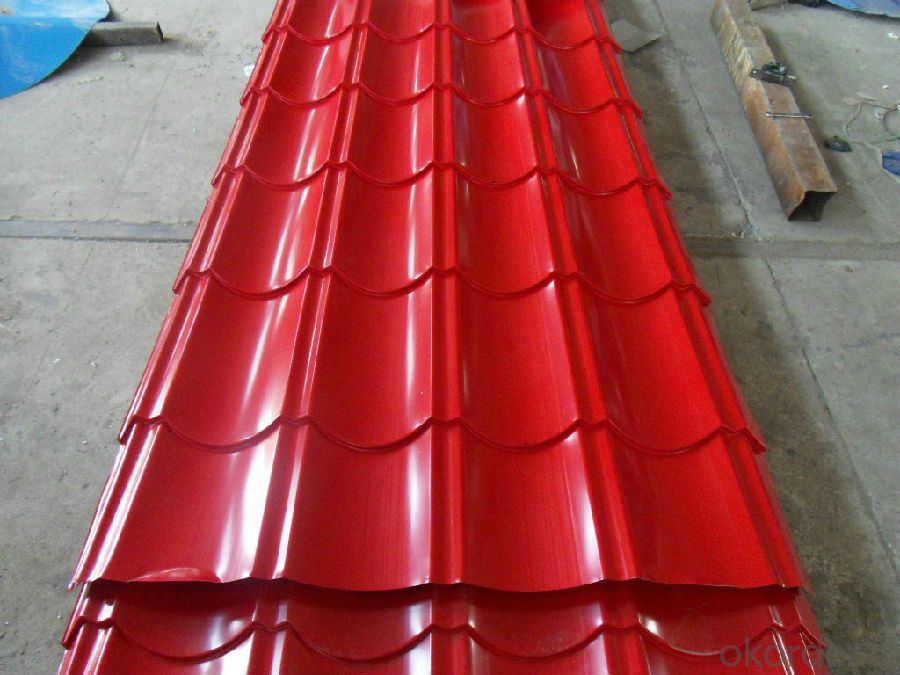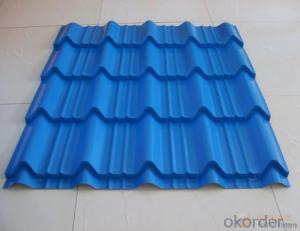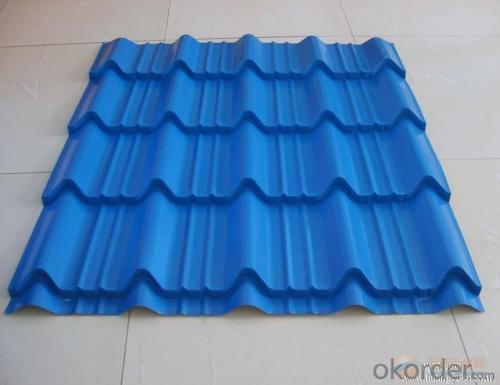High Quality of Corrugated Prepainted Galvanized Steel Sheet from China
- Loading Port:
- Tianjin
- Payment Terms:
- TT OR LC
- Min Order Qty:
- 50 m.t.
- Supply Capability:
- 10000 m.t./month
OKorder Service Pledge
OKorder Financial Service
You Might Also Like
1. Pre-Painted Galvanized/Aluzinc Steel Roof Description:
With GI as base material, after pretreatment (degrease and chemical treatment ) and liquid dope with several layers of color, then after firing and cooling, finally the plate steel is called pre-painted galvanized (aluzinc) steel. Pre-painted galvanized roof is good capable of decoration, molding, corrosion resistance. It generally displays superior workability, durability and weather resistance.
2.Main Features of the Pre-Painted Galvanized/Aluzinc Steel Roof:
• Excellent process capability
• Smooth and flat surface
• Workability, durability
• Excellent heat resistance performance
• High strength
• Good formability
• Good visual effect
3.Pre-Painted Galvanized/Aluzinc Steel Roof Images

4.Pre-Painted Galvanized/Aluzinc Steel Roof Specification
Standard: AISI, ASTM, BS, DIN, GB, JIS
Grade: SGCC SGCH SGCD DX51D
Thickness: 0.13-3.0mm
Model Number: AISI, ASTM, BS, DIN, GB, JIS
Type: Steel Plate
Technique: Cold Rolled
Surface Treatment: Galvanized
Application: Container Plate
Special Use: High-strength Steel Plate
Width: 30-1500mm
Length: any length
color: RAL color
5.FAQ of Pre-Painted Galvanized/Aluzinc Steel Roof
What’s the brand of the paint?
We use the best brand of all of the word—AKZO.
What’s the wet and heat resistance of the roof?
More than 1000 hours.
- Q: If steel content is too cheap, what content should I be looking for? I don't think I could find something like a VG-10 here...
- I am a former chef and have used Chinese chefs knives, different types from cleavers, even french knives, they are mostly carbon steel, and are made with a cold forged process, they are as good as the European knives and are marketability cheaper, I have one a french knife a 8 one with a green non porous handle. I like it, it is light weight and very well made, and keeps an edge quite well, just look for the better type available.
- Q: How are steel coils used in the production of agricultural implements?
- Steel coils are used in the production of agricultural implements as they are typically rolled into specific shapes and sizes to create parts such as blades, tines, and plowshares. These coils provide the necessary strength and durability required for farm machinery to withstand the demanding conditions of agricultural work.
- Q: How are steel coils protected against fire and heat?
- To ensure the safety of steel coils, various methods are used to protect them from fire and heat. One effective way is by applying a fire-resistant coating, which acts as a barrier between the steel surface and the heat source. This coating prevents direct contact and reduces the chances of ignition or damage. Aside from coatings, steel coils can also be stored in fire-resistant warehouses or storage facilities. These structures are built with fire-resistant materials like concrete or steel and equipped with fire suppression systems such as sprinklers or fire extinguishers. These measures help contain and suppress any potential fire, effectively limiting its spread and safeguarding the steel coils. Furthermore, facilities that handle steel coils often implement fire safety protocols and procedures. These may include regular fire drills, training programs for employees on fire prevention and response, and the installation of fire safety equipment like fire alarms and fire hoses. These measures ensure that any fire incidents can be quickly detected and addressed, minimizing the risk to the steel coils. Overall, protecting steel coils against fire and heat involves a combination of fire-resistant coatings, proper storage in fire-resistant structures, and the implementation of fire safety protocols. These measures work together to mitigate the risk of fire and heat-related damage, ensuring the integrity and safety of the steel coils.
- Q: In pounds per square inch what is the tensile strength of strong steel?
- Depends on what you mean by strong steel. Typically the ultimate strength/yield point of steel used for building structures (beams, columns, joists, plates) is in the range of 36,000 to 50,000 psi. The strength is specified by the designer (in the U.S.) by its ASTM designation. e.g. ASTM A36, A572, A500, A307, A325 ... A36 is typical mild steel, A572 Grade 50 (50,000 psi) is often called high-strength Really high strength steels such as pre-stressing strand can have ultimate strengths more than 10 times these values.
- Q: Two different shaving razors I'm looking to buy have different specs. in terms of the metals used for the blade; one being 1045 surgical stainless steel, the other 440 stainless (not sure if its A B or C, but probably 440A or 440B because it's not specified). So which one is better for the intended use as a shaving razor?
- yes a stainless steel 440 knife is really good my uncle bought one back in 1979 and has been having it without any problems the blade is still razor sharp even at 35 years old
- Q: How are steel coils tested for strength and durability?
- Steel coils are tested for strength and durability through various methods such as tensile testing, impact testing, and fatigue testing. Tensile testing involves subjecting the steel coil to tension until it breaks, measuring the maximum force it can withstand. Impact testing involves striking the coil with a heavy object to assess its ability to resist sudden shocks. Fatigue testing involves subjecting the coil to repeated load cycles to determine its resistance to long-term stress. These tests help ensure that steel coils meet the required strength and durability standards.
- Q: How are steel coils used in the manufacturing of wires?
- Steel coils are used in the manufacturing of wires by being fed into wire drawing machines where they are elongated and reduced in diameter to the desired thickness. The steel coils provide a continuous supply of raw material, ensuring a seamless production process for manufacturing wires of various sizes and applications.
- Q: How do steel coils contribute to the construction machinery industry?
- Steel coils are an essential component in the construction machinery industry. They play a crucial role in the manufacturing of heavy-duty machinery and equipment used in construction projects. One of the primary ways steel coils contribute to the construction machinery industry is through their use in the fabrication of structural components. These coils are often processed and shaped into beams, plates, and tubes, which form the framework of construction machinery. The strength and durability of steel make it an ideal material for these applications, as it can withstand heavy loads and harsh working conditions. Moreover, steel coils are also used in the production of various mechanical parts and components found in construction machinery. These include gears, shafts, axles, and hydraulic system components. The versatility of steel allows it to be easily machined and formed into complex shapes, enabling the creation of efficient and reliable machinery parts. In addition to its mechanical properties, steel coils also contribute to the construction machinery industry through their corrosion resistance. Construction machinery is often exposed to moisture, chemicals, and other environmental factors that can cause rust and deterioration. Steel coils with proper coatings or finishes can provide protection against corrosion, ensuring the longevity and performance of construction machinery. Furthermore, the availability and affordability of steel coils make them a preferred material for the construction machinery industry. Steel is widely produced and can be sourced from various suppliers, ensuring a steady supply chain. Its cost-effectiveness compared to other materials makes it an attractive option for manufacturers, allowing them to produce machinery at competitive prices. Overall, steel coils are vital to the construction machinery industry by providing strength, durability, corrosion resistance, and cost-effectiveness. Their use in the fabrication of structural components and mechanical parts ensures the reliability and efficiency of construction machinery, contributing to the growth and development of the industry.
- Q: Which one would be stronger? And should damascus steel be tempered?Thank You
- it depends on so many factors first of all is it functional damascus steel or can you see the grain? what type of carbon steel is it generally most makers use1045- 1060 a good quote of something I read was asking what steel is best for a sword is like asking how long string should be generally if they say carbon steel and do not say what grade it is they mean 1045 meaning it has 4.5 carbon content now this if properly tempered can make a good sword but it would not be known for it's durability or it's edge retention it would be average at these things as for damascus steel well as I said before it is just any steel that has been folded some people think it has magical properties imparted by the folding process but it is just steel there is slightly a higher chance of a damascus steel sword having deposits of impurities along the blade and at cheaper blades this risk is even higher that being said many good swords made of damascus on the market are very good quality any sword no matter if it is made of damascus, carbon, spring. or tool steel should be tempered always no question about that
- Q: What website can I use to find a good picture that shows the atomic structure of a carbon steel?
- You know, I'd have to say it's very complex.
Send your message to us
High Quality of Corrugated Prepainted Galvanized Steel Sheet from China
- Loading Port:
- Tianjin
- Payment Terms:
- TT OR LC
- Min Order Qty:
- 50 m.t.
- Supply Capability:
- 10000 m.t./month
OKorder Service Pledge
OKorder Financial Service
Similar products
Hot products
Hot Searches
Related keywords




























